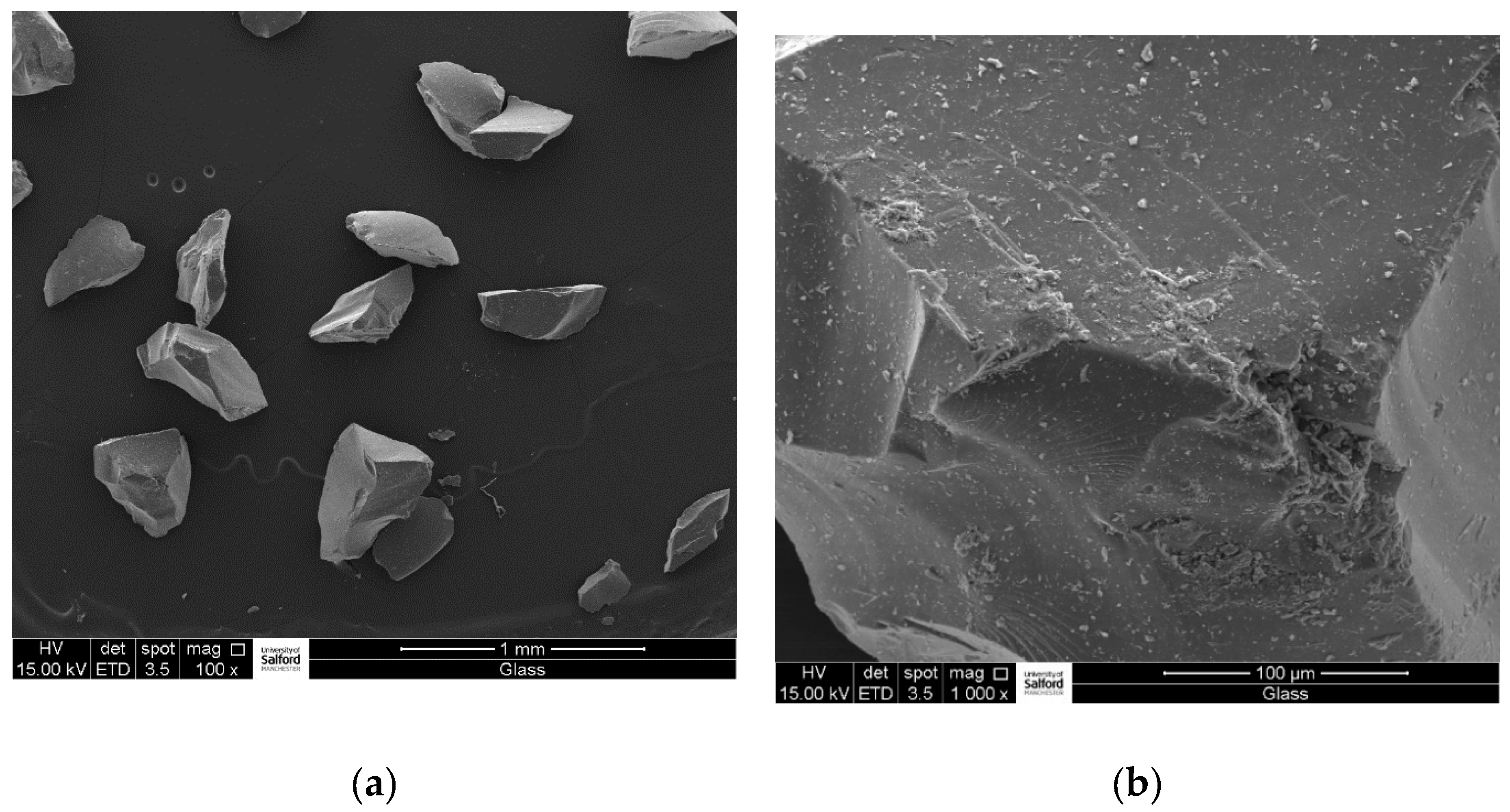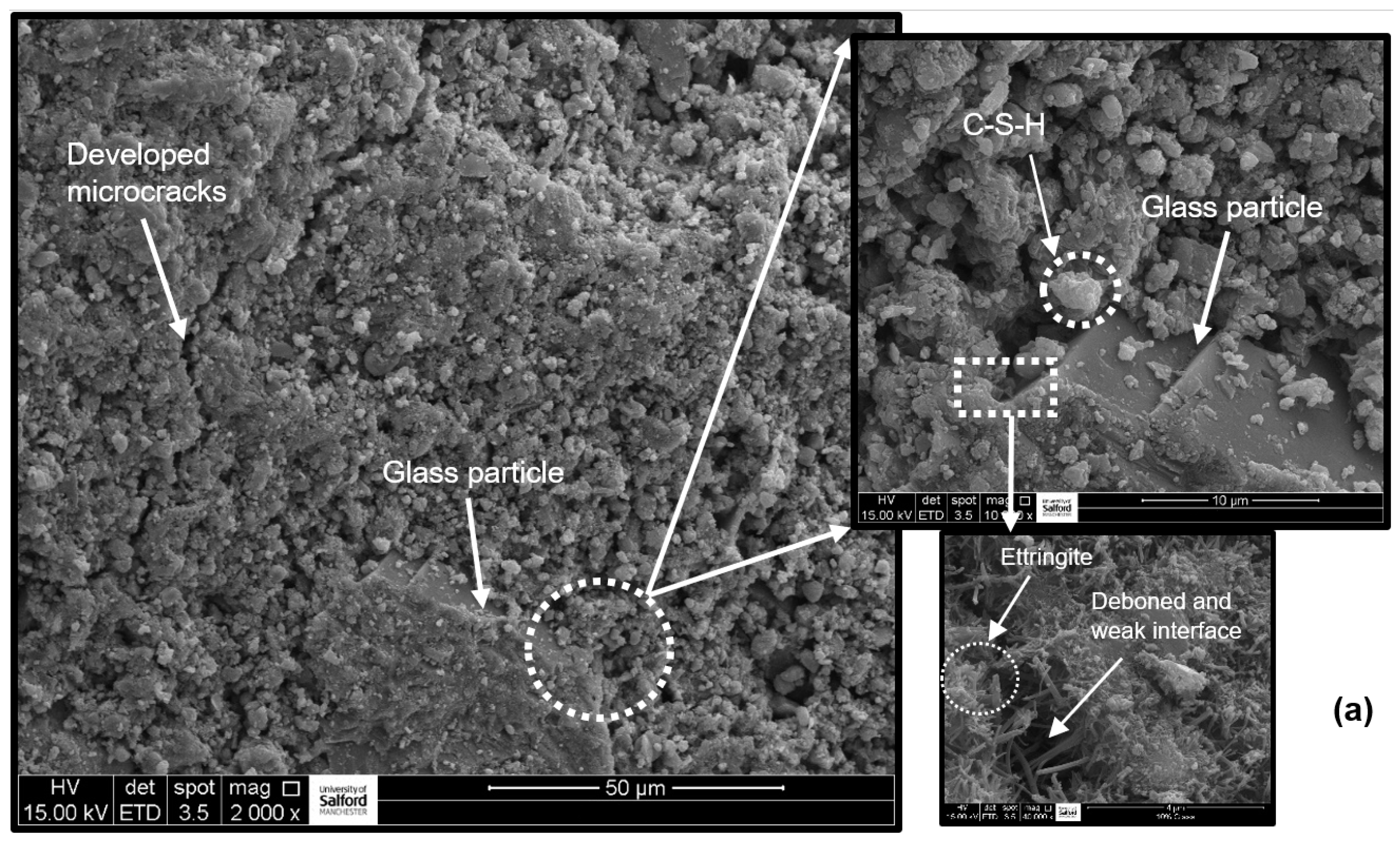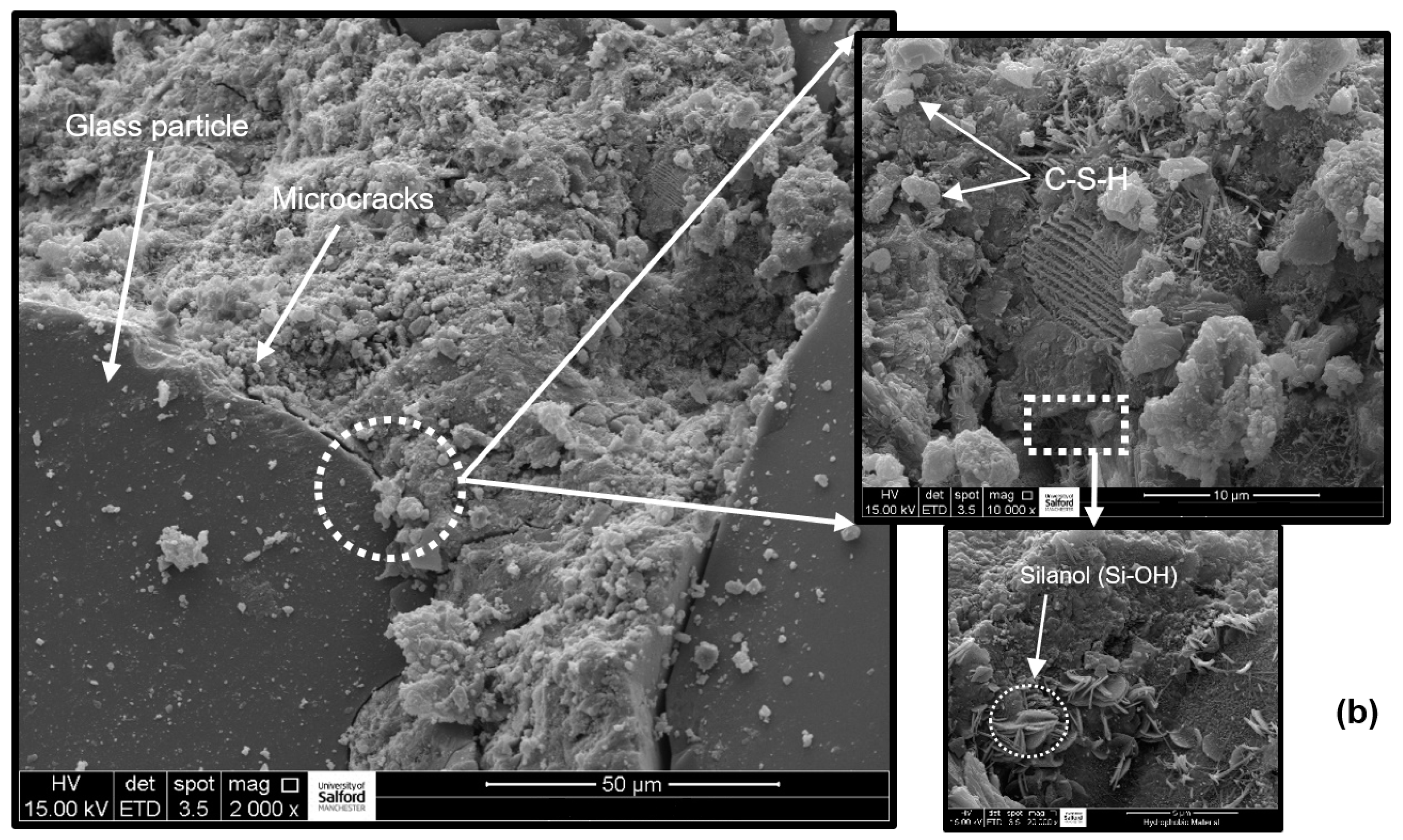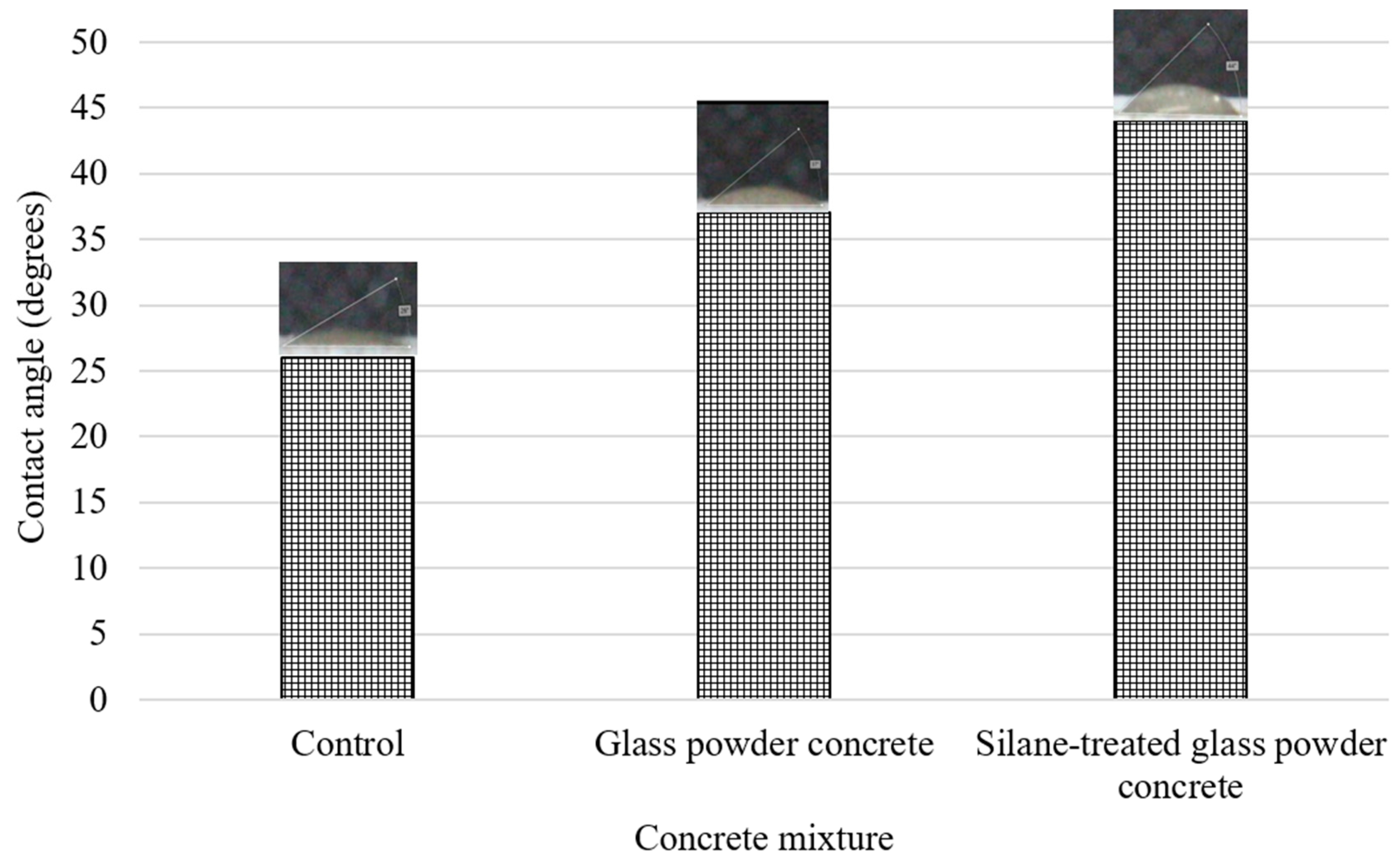Sustainable Valorisation of Silane-Treated Waste Glass Powder in Concrete Pavement
Abstract
:1. Introduction
2. Experimental Methodology
2.1. Materials
2.2. Mix Design and Formulation
2.3. Test Specifications and Specimens
3. Results and Discussion
3.1. Microstructural Analysis and Interfacial Bonding Properties
3.2. Functional Properties
3.2.1. Concrete Consistency
3.2.2. Hydrophobic Effect
3.2.3. Water Absorption
3.3. Mechanical Properties
3.3.1. The Effect of Glass Powder on Compressive Strength
3.3.2. The Effect of Glass Powder on Flexural Strength
4. Conclusions
- The microstructural investigation was able to show the changes in the morphology of concrete after the addition of treated and untreated glass powder, which explained the reasons behind the changes in the physical and mechanical properties of concrete.
- Untreated glass powder can have a negative effect on concrete at the early age of 7 days and lead to increased water absorption and decreased compressive and flexural strengths compared to the control. In contrast, a decrease in water absorption and an increase in compressive and flexural strength were observed at later stages due to the progression of the hydration process and the filling effect of glass particles in the pores.
- The silane coating of the added glass powder can enhance the compressive and flexural strengths and the impermeability of concrete at 7 days and 28 days. This is probably due to the coupling effect of silane, which enhances the linking between glass particles and the cementitious matrix.
- The hydrophobicity of concrete was observed to increase after the inclusion of glass powder. However, higher levels of hydrophobicity were obtained after the treatment of glass powder with silane. Glass powder has an amorphous and smooth texture that increases the contact angle of concrete. Adding silane to glass powder will increase the contact angle to higher levels. This can be reflected in the enhanced impermeability of concrete.
Author Contributions
Funding
Data Availability Statement
Acknowledgments
Conflicts of Interest
References
- Udomsap, A.D.; Hallinger, P. A bibliometric review of research on sustainable construction, 1994–2018. J. Clean. Prod. 2020, 254, 120073. [Google Scholar] [CrossRef]
- Goncalves, J.; El-Bakkari, M.; Boluk, Y.; Bindiganavile, V. Cellulose nanofibres (CNF) for sulphate resistance in cement based systems. Cem. Concr. Compos. 2019, 99, 100–111. [Google Scholar] [CrossRef]
- Zavadskas, E.K.; Šaparauskas, J.; Antuchevičienė, J. Sustainability in construction engineering. Sustainability 2018, 10, 2236. [Google Scholar] [CrossRef] [Green Version]
- Šaparauskas, J.; Turskis, Z. Evaluation of construction sustainability by multiple criteria methods. Technol. Econ. Dev. Econ. 2006, 12, 321–326. [Google Scholar] [CrossRef]
- Seyfang, G. Community action for sustainable housing: Building a low-carbon future. Energy Policy 2010, 38, 7624–7633. [Google Scholar] [CrossRef] [Green Version]
- Bon, R.; Hutchinson, K. Sustainable construction: Some economic challenges. Build. Res. Inf. 2000, 28, 310–314. [Google Scholar] [CrossRef]
- Zhao, X.; Zuo, J.; Wu, G.; Huang, C. A bibliometric review of green building research 2000–2016. Archit. Sci. Rev. 2019, 62, 74–88. [Google Scholar] [CrossRef]
- Kline, J.; Barcelo, L. Cement and CO2, a victim of success! In Proceedings of the 2012 IEEE-IAS/PCA 54th Cement Industry Technical Conference (IEEE), San Antonio, TX, USA, 14–17 May 2012; pp. 1–14. [Google Scholar]
- Barlow, J.; Jashapara, A. Organisational learning and inter-firm “partnering” in the UK construction industry. Learn. Organ. 1998, 5, 86–98. [Google Scholar] [CrossRef]
- Kisku, N.; Joshi, H.; Ansari, M.; Panda, S.K.; Nayak, S.; Dutta, S.C. A critical review and assessment for usage of recycled aggregate as sustainable construction material. Constr. Build. Mater. 2017, 131, 721–740. [Google Scholar] [CrossRef]
- Ren, P.; Li, B.; Yu, J.G.; Ling, T.C. Utilization of recycled concrete fines and powders to produce alkali-activated slag concrete blocks. J. Clean. Prod. 2020, 267, 122115. [Google Scholar] [CrossRef]
- Maddalena, R.; Roberts, J.J.; Hamilton, A. Can Portland cement be replaced by low-carbon alternative materials? A study on the thermal properties and carbon emissions of innovative cements. J. Clean. Prod. 2018, 186, 933–942. [Google Scholar] [CrossRef]
- Rashad, A.M.; Sadek, D.M.; Hassan, H.A. An investigation on blast-furnace stag as fine aggregate in alkali-activated slag mortars subjected to elevated temperatures. J. Clean. Prod. 2016, 112, 1086–1096. [Google Scholar] [CrossRef]
- Gartner, E. Industrially interesting approaches to “low-CO2” cements. Cem. Concr. Res. 2004, 34, 1489–1498. [Google Scholar] [CrossRef]
- Flower, D.J.; Sanjayan, J.G. Green house gas emissions due to concrete manufacture. Int. J. Life Cycle Assess. 2007, 12, 282–288. [Google Scholar] [CrossRef]
- Shelote, K.M.; Gavali, H.R.; Bras, A.; Ralegaonkar, R.V. Utilization of Co-Fired Blended Ash and Chopped Basalt Fiber in the Development of Sustainable Mortar. Sustainability 2021, 13, 1247. [Google Scholar] [CrossRef]
- Tayeh, B.A.; Al Saffar, D.M.; Alyousef, R. The utilization of recycled aggregate in high performance concrete: A review. J. Mater. Res. Technol. 2020, 9, 8469–8481. [Google Scholar] [CrossRef]
- Azad, N.M.; Samarakoon, S.M. Utilization of Industrial By-Products/Waste to Manufacture Geopolymer Cement/Concrete. Sustainability 2021, 13, 873. [Google Scholar] [CrossRef]
- Martínez-García, R.; Rojas, M.I.S.D.; Pozo, J.M.; Fraile-Fernández, F.J.; Juan-Valdés, A. Evaluation of Mechanical Characteristics of Cement Mortar with Fine Recycled Concrete Aggregates (FRCA). Sustainability 2021, 13, 414. [Google Scholar] [CrossRef]
- Li, Q.; Hu, J. Mechanical and Durability Properties of Cement-Stabilized Recycled Concrete Aggregate. Sustainability 2020, 12, 7380. [Google Scholar] [CrossRef]
- Zapata, P.; Gambatese, J.A. Energy consumption of asphalt and reinforced concrete pavement materials and construction. J. Infrastruct. Syst. 2005, 11, 9–20. [Google Scholar] [CrossRef]
- Ghaffar, S.H.; Burman, M.; Braimah, N. Pathways to circular construction: An integrated management of construction and demolition waste for resource recovery. J. Clean. Prod. 2020, 244, 118710. [Google Scholar] [CrossRef]
- Al-Kheetan, M.J.; Rahman, M.M.; Ghaffar, S.H.; Jweihan, Y.S. Comprehensive Investigation of the Long-term Performance of Internally Integrated Concrete Pavement with Sodium Acetate. Results Eng. 2020, 6, 100110. [Google Scholar] [CrossRef]
- Ghaffar, S.H.; Al-Kheetan, M.; Ewens, P.; Wang, T.; Zhuang, J. Investigation of the interfacial bonding between flax/wool twine and various cementitious matrices in mortar composites. Constr. Build. Mater. 2020, 239, 117833. [Google Scholar] [CrossRef]
- Shi, X.; Mukhopadhyay, A.; Zollinger, D. Sustainability assessment for portland cement concrete pavement containing reclaimed asphalt pavement aggregates. J. Clean. Prod. 2018, 192, 569–581. [Google Scholar] [CrossRef]
- Li, L.J.; Tu, G.R.; Lan, C.; Liu, F. Mechanical characterization of waste-rubber-modified recycled-aggregate concrete. J. Clean. Prod. 2016, 124, 325–338. [Google Scholar] [CrossRef]
- Liu, F.; Meng, L.Y.; Ning, G.F.; Li, L.J. Fatigue performance of rubber-modified recycled aggregate concrete (RRAC) for pavement. Constr. Build. Mater. 2015, 95, 207–217. [Google Scholar] [CrossRef]
- James, M.N.; Choi, W.; Abu-Lebdeh, T. Use of recycled aggregate and fly ash in concrete pavement. Am. J. Eng. Appl. Sci. 2011, 4, 201–208. [Google Scholar] [CrossRef] [Green Version]
- Albar, A.; Chougan, M.; Al-Kheetan, M.J.; Swash, M.R.; Ghaffar, S.H. Effective extrusion-based 3D printing system design for cementitious-based materials. Results Eng. 2020, 6, 100135. [Google Scholar] [CrossRef]
- Naeini, M.; Mohammadinia, A.; Arulrajah, A.; Horpibulsuk, S. Recycled Glass Blends with Recycled Concrete Aggregates in Sustainable Railway Geotechnics. Sustainability 2021, 13, 2463. [Google Scholar] [CrossRef]
- Hendi, A.; Mostofinejad, D.; Sedaghatdoost, A.; Zohrabi, M.; Naeimi, N.; Tavakolinia, A. Mix design of the green self-consolidating concrete: Incorporating the waste glass powder. Constr. Build. Mater. 2019, 199, 369–384. [Google Scholar] [CrossRef]
- Collivignarelli, M.C.; Cillari, G.; Ricciardi, P.; Miino, M.C.; Torretta, V.; Rada, E.C.; Abbà, A. The Production of Sustainable Concrete with the Use of Alternative Aggregates: A Review. Sustainability 2020, 12, 7903. [Google Scholar] [CrossRef]
- Lee, H.; Hanif, A.; Usman, M.; Sim, J.; Oh, H. Performance evaluation of concrete incorporating glass powder and glass sludge wastes as supplementary cementing material. J. Clean. Prod. 2018, 170, 683–693. [Google Scholar] [CrossRef]
- Paul, S.C.; Šavija, B.; Babafemi, A.J. A comprehensive review on mechanical and durability properties of cement-based materials containing waste recycled glass. J. Clean. Prod. 2018, 198, 891–906. [Google Scholar] [CrossRef]
- Androjić, I.; Dimter, S. Properties of hot mix asphalt with substituted waste glass. Mater. Struct. 2016, 49, 249–259. [Google Scholar] [CrossRef]
- Shafabakhsh, G.H.; Sajed, Y. Investigation of dynamic behavior of hot mix asphalt containing waste materials; case study: Glass cullet. Case Stud. Constr. Mater. 2014, 1, 96–103. [Google Scholar] [CrossRef] [Green Version]
- Simone, A.; Mazzotta, F.; Eskandarsefat, S.; Sangiorgi, C.; Vignali, V.; Lantieri, C.; Dondi, G. Experimental application of waste glass powder filler in recycled dense-graded asphalt mixtures. Road Mater. Pavement Des. 2019, 20, 592–607. [Google Scholar] [CrossRef] [Green Version]
- Rahman, M.T.; Mohajerani, A.; Giustozzi, F. Recycling of waste materials for asphalt concrete and bitumen: A review. Materials 2020, 13, 1495. [Google Scholar] [CrossRef] [PubMed] [Green Version]
- Salem, Z.T.A.; Khedawi, T.S.; Baker, M.B.; Abendeh, R. Effect of waste glass on properties of asphalt concrete mixtures. Jordan J. Civ. Eng. 2017, 11, 117–131. [Google Scholar]
- Xiao, R.; Polaczyk, P.; Zhang, M.; Jiang, X.; Zhang, Y.; Huang, B.; Hu, W. Evaluation of glass powder-based geopolymer stabilized road bases containing recycled waste glass aggregate. Transp. Res. Rec. 2020, 2674, 22–32. [Google Scholar] [CrossRef]
- Jani, Y.; Hogland, W. Waste glass in the production of cement and concrete—A review. J. Environ. Chem. Eng. 2014, 2, 1767–1775. [Google Scholar] [CrossRef]
- Topcu, I.B.; Canbaz, M. Properties of concrete containing waste glass. Cem. Concr. Res. 2004, 34, 267–274. [Google Scholar] [CrossRef]
- Vellini, M.; Savioli, M. Energy and environmental analysis of glass container production and recycling. Energy 2009, 34, 2137–2143. [Google Scholar] [CrossRef]
- Gualtieri, M.L.; Mugoni, C.; Guandalini, S.; Cattini, A.; Mazzini, D.; Alboni, C.; Siligardi, C. Glass recycling in the production of low-temperature stoneware tiles. J. Clean. Prod. 2018, 197, 1531–1539. [Google Scholar] [CrossRef]
- Andreola, F.; Barbieri, L.; Corradi, A.; Lancellotti, I. CRT glass state of the art: A case study: Recycling in ceramic glazes. J. Eur. Ceram. Soc. 2007, 27, 1623–1629. [Google Scholar] [CrossRef]
- Guo, M.Z.; Chen, Z.; Ling, T.C.; Poon, C.S. Effects of recycled glass on properties of architectural mortar before and after exposure to elevated temperatures. J. Clean. Prod. 2015, 101, 158–164. [Google Scholar] [CrossRef]
- Gautam, S.P.; Srivastava, V.; Agarwal, V.C. Use of glass wastes as fine aggregate in Concrete. J. Acad. Indus. Res. 2012, 1, 320–322. [Google Scholar]
- Bisht, K.; Ramana, P.V. Sustainable production of concrete containing discarded beverage glass as fine aggregate. Constr. Build. Mater. 2018, 177, 116–124. [Google Scholar] [CrossRef]
- de Castro, S.; de Brito, J. Evaluation of the durability of concrete made with crushed glass aggregates. J. Clean. Prod. 2013, 41, 7–14. [Google Scholar] [CrossRef]
- Afshinnia, K.; Rangaraju, P.R. Impact of combined use of ground glass powder and crushed glass aggregate on selected properties of Portland cement concrete. Constr. Build. Mater. 2016, 117, 263–272. [Google Scholar] [CrossRef]
- Al-Kheetan, M.J.; Rahman, M.M.; Chamberlain, D.A. Fundamental interaction of hydrophobic materials in concrete with different moisture contents in saline environment. Constr. Build. Mater. 2019, 207, 122–135. [Google Scholar] [CrossRef]
- Al-Kheetan, M.J.; Rahman, M.M.; Chamberlain, D.A. Moisture evaluation of concrete pavement treated with hydrophobic surface impregnants. Int. J. Pavement Eng. 2020, 21, 1746–1754. [Google Scholar] [CrossRef]
- Al-Kheetan, M.J.; Rahman, M.M.; Balakrishna, M.N.; Chamberlain, D.A. Performance enhancement of self-compacting concrete in saline environment by hydrophobic surface protection. Can. J. Civ. Eng. 2019, 46, 677–686. [Google Scholar] [CrossRef]
- British Standards Institution. BS EN 197-1:2011: Cement. Composition, Specifications and Conformity Criteria for Common Cements; British Standards Institution: London, UK, 2011. [Google Scholar]
- Chemical Book Inc. Vinyl tris(2-methoxyethoxy) Silane|1067-53-4. 2016. Available online: https://www.chemicalbook.com/ChemicalProductProperty_EN_CB4483357.htm (accessed on 18 October 2020).
- British Standards Institution. BS 1881-125:2013: Testing Concrete. Methods for Mixing and Sampling Fresh Concrete in the Laboratory; British Standards Institution: London, UK, 2013. [Google Scholar]
- Talor, P.; Yurdakul, E.; Wang, X.; Wang, X. Concrete pavement mixture design and analysis (MDA): An innovative approach to proportioning concrete mixtures. InTrans Proj. Rep. 2015, 106. Available online: http://lib.dr.iastate.edu/intrans_reports/10 (accessed on 10 September 2020).
- British Standards Institution. 12350-2:2009: Testing Fresh Concrete. Slump-Test; British Standards Institution: London, UK, 2009. [Google Scholar]
- Anderson, A.M.; Carroll, M.K. Aerogels Handbook; Leventis, N., Koebel, M.M., Eds.; Springer: Berlin, Germany, 2011. [Google Scholar]
- Al-Kheetan, M.J.; Rahman, M.M. Integration of anhydrous sodium acetate (ASAc) into concrete pavement for protection against harmful impact of deicing salt. JOM 2019, 71, 4899–4909. [Google Scholar] [CrossRef] [Green Version]
- American Society for Testing and Materials. ASTM D 6489-99, Standard Test Method for Determining the Water Absorption of Hardened Concrete Treated with a Water Repellent Coating; American Society for Testing and Materials: Conshohocken, PA, USA, 1999. [Google Scholar]
- British Standards Institution. BS EN 12390-5:2009: Testing Hardened Concrete. Compressive Strength of Test Specimens; British Standards Institution: London, UK, 2009. [Google Scholar]
- British Standards Institution. BS EN 12390-3:2009: Testing Hardened Concrete. Flexural Strength of Test Specimens; British Standards Institution: London, UK, 2009. [Google Scholar]
- Dyer, T.D.; Dhir, R.K. Chemical reactions of glass cullet used as cement component. J. Mater. Civ. Eng. 2001, 13, 412–417. [Google Scholar] [CrossRef]
- Jin, W.; Meyer, C.; Baxter, S. “Glascrete”-Concrete with Glass Aggregate. ACI Mater. J. 2000, 97, 208–213. [Google Scholar]
- Kong, Y.; Wang, P.; Liu, S.; Zhao, G.; Peng, Y. SEM analysis of the interfacial transition zone between cement-glass powder paste and aggregate of mortar under microwave curing. Materials 2016, 9, 733. [Google Scholar] [CrossRef] [PubMed] [Green Version]
- Murray, C.D.; Deschenes, R.A., Jr.; Hale, W.M. Durability of Silane Sealer in Highly Alkaline Environment. ACI Mater. J. 2016, 113, 387–393. [Google Scholar] [CrossRef] [Green Version]
- Feng, H.; Le, H.T.N.; Wang, S.; Zhang, M.H. Effects of silanes and silane derivatives on cement hydration and mechanical properties of mortars. Constr. Build. Mater. 2016, 129, 48–60. [Google Scholar] [CrossRef]
- Rahma, A.; El Naber, N.; Ismail, S.I. Effect of glass powder on the compression strength and the workability of concrete. Cogent Eng. 2017, 4, 1373415. [Google Scholar] [CrossRef]
- Islam, G.S.; Rahman, M.H.; Kazi, N. Waste glass powder as partial replacement of cement for sustainable concrete practice. Int. J. Sustain. Built Environ. 2017, 6, 37–44. [Google Scholar] [CrossRef] [Green Version]









| Ingredient | Amount (kg/m3) |
|---|---|
| Cement (CEM I/42.5 N; sulphates <3.5%, chlorides <0.10%, and initial setting time 40 min) | 450 |
| Water | 180 |
| Fine aggregate (sharp river sand with a uniform grain size distribution between 2 mm and 300 µm) | 678 |
| Coarse aggregate (crushed granite with sharp edges and maximum size of 20 mm) | 1092 |
| Concrete Mix | Slump (mm) |
|---|---|
| Control | 29 |
| Concrete with 10% glass powder | 31 |
| Concrete with 10% glass powder and treated with silane | 33 |
Publisher’s Note: MDPI stays neutral with regard to jurisdictional claims in published maps and institutional affiliations. |
© 2021 by the authors. Licensee MDPI, Basel, Switzerland. This article is an open access article distributed under the terms and conditions of the Creative Commons Attribution (CC BY) license (https://creativecommons.org/licenses/by/4.0/).
Share and Cite
Al-Kheetan, M.J.; Byzyka, J.; Ghaffar, S.H. Sustainable Valorisation of Silane-Treated Waste Glass Powder in Concrete Pavement. Sustainability 2021, 13, 4949. https://doi.org/10.3390/su13094949
Al-Kheetan MJ, Byzyka J, Ghaffar SH. Sustainable Valorisation of Silane-Treated Waste Glass Powder in Concrete Pavement. Sustainability. 2021; 13(9):4949. https://doi.org/10.3390/su13094949
Chicago/Turabian StyleAl-Kheetan, Mazen J., Juliana Byzyka, and Seyed Hamidreza Ghaffar. 2021. "Sustainable Valorisation of Silane-Treated Waste Glass Powder in Concrete Pavement" Sustainability 13, no. 9: 4949. https://doi.org/10.3390/su13094949







